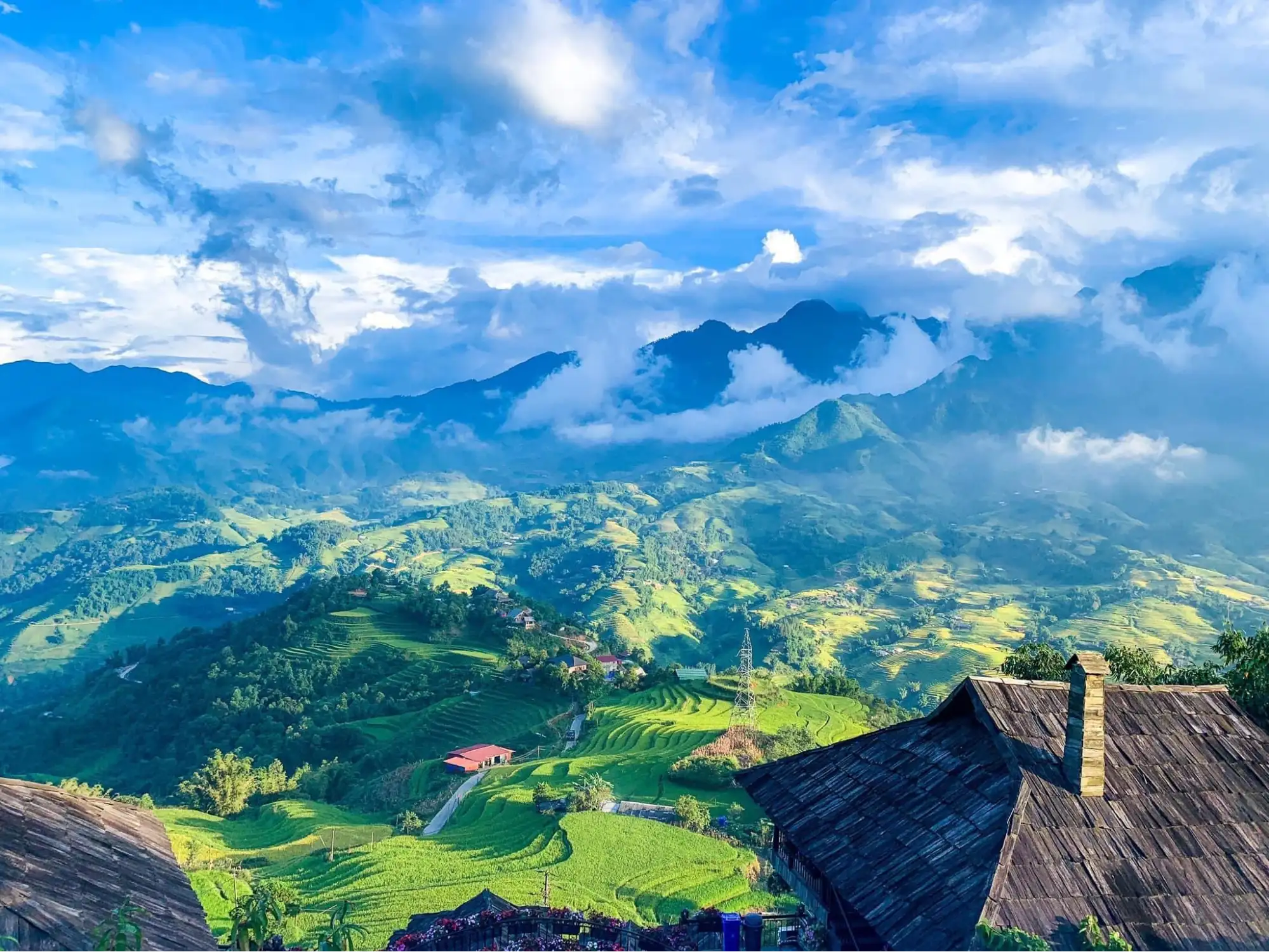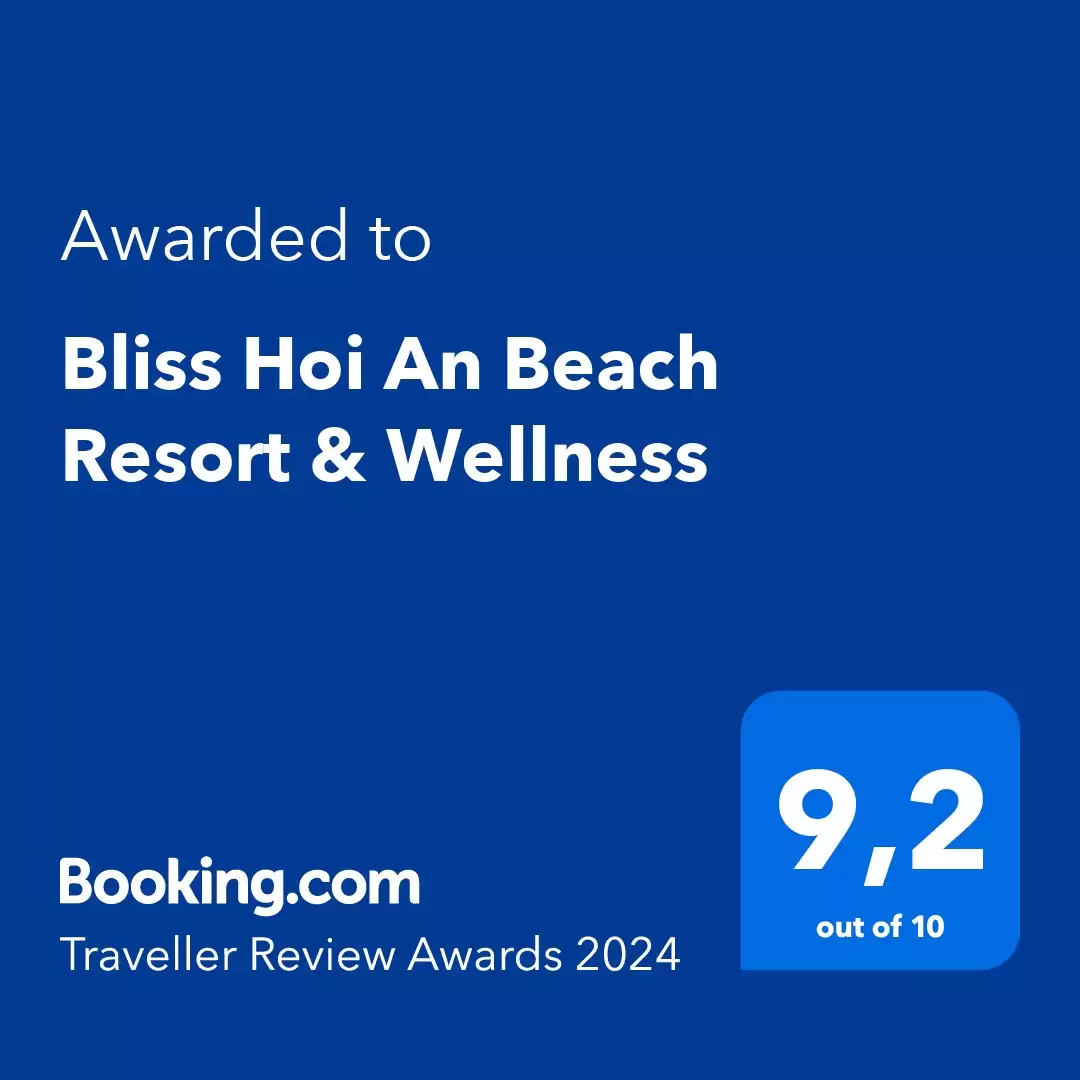How to travel Vietnam in 2 weeks: A complete itinerary for the ultimate experience
If you’ve been wondering how to travel Vietnam in 2 weeks, this itinerary is the perfect guide to help you explore the best of what this beautiful country has to offer. Get ready to make the most of your 2-week vacation and create memories that will last a lifetime!
Why you should spend two weeks traveling in Vietnam?
Spending two weeks traveling in Vietnam is the perfect amount of time to fully experience the country’s diverse beauty and deep cultural richness. With a territory stretching over 1,600 kilometers from north to south, each region of Vietnam offers its own unique identity in terms of nature, cuisine, history, and people.

In just 14 days, travelers can witness the dramatic contrasts between Vietnam’s three regions. The journey may begin in the cool, elegant north, where ancient capitals and mist-covered mountains preserve centuries-old customs. As you move through the central region, you will walk in the footsteps of emperors, wander lantern-lit streets, and enjoy some of the country’s finest cuisine.
The trip continues into the vibrant south, where the energy of modern life pulses through Ho Chi Minh City and the Mekong Delta opens into tranquil waters and floating villages. Two weeks allows you to experience this north-to-south progression with depth, reflection, and discovery.
Another reason to spend two weeks in Vietnam lies in the country’s extraordinary diversity. It is this kind of slow travel that creates lasting memories and a deeper connection to the places you visit.
Visiting Vietnam between October and April promises the most rewarding experience. During these months, the weather is most pleasant across the country. Traveling during this season means you can embrace Vietnam’s outdoor lifestyle, witness festivals, and explore its nature without weather disruptions. If you’re looking for the best time how to travel Vietnam in 2 weeks, this period offers the ideal weather for a memorable trip.
Read more: South and Central Vietnam itinerary: The perfect 10 – 14 day travel guide
Discover the best of Vietnam: A 2-week travel itinerary
The 2-week Vietnam travel itinerary offers the perfect opportunity to explore must-see destinations, savor unique cuisine, and experience the distinctive features of each region. If you’re wondering how to travel Vietnam in 2 weeks, this itinerary will guide you through an unforgettable journey.
Day 1: Explore Hanoi

- Morning:
- Breakfast: Pho Hanoi – known for its clear, fragrant broth, Hanoi-style pho is a blend of slow-simmered beef bones and traditional spices. Interestingly, each district in Hanoi offers a unique version, from rare beef to chicken pho, each with its own distinct flavor.
- Visit Hoan Kiem lake: This picturesque lake holds spiritual significance due to the legend of the Turtle God. A stroll around the lake offers a peaceful contrast to the city’s hustle and bustle.
- Ngoc Son temple: Located on a small island in the lake, this 19th-century temple is accessible via the iconic red-painted The Huc Bridge, known as “The Bridge of Rising Sun” and features classic Vietnamese design.
- Afternoon:
- Lunch: Bun Cha – Grilled pork patties served with vermicelli, herbs, and a tangy fish sauce dip. The pork is grilled over charcoal for a smoky, crispy texture.
- Explore Hanoi Old Quarter: A maze of 36 ancient streets, each originally dedicated to a specific trade. The buildings here are long and narrow, designed to save space in this densely populated district.
- Hanoi Opera House: A masterpiece of French colonial architecture, this grand structure also hosts live opera and musical performances that reflect the city’s rich cultural heritage.
- Evening:
- Dinner: Cha Ca La Vong – A signature Hanoi dish made with grilled snakehead fish, marinated with turmeric and galangal, cooked at the table with dill and served with rice noodles and shrimp paste.
- Stroll around Hoan Kiem Walking Street: On weekends, this area becomes a vibrant cultural space where you can sample traditional snacks like banh ran (fried glutinous rice balls) and enjoy local music, street performances, and folk games.
Day 2: Continue to explore Hanoi

- Morning:
- Breakfast: Thanh Tri steamed rice rolls (banh cuon) – Thin rice sheets filled with minced pork and wood ear mushrooms, typically eaten with grilled pork and a special sweet-spicy fish sauce.
- Visit Ho Chi Minh Mausoleum: A solemn site where Vietnam’s revered leader is laid to rest. The architecture reflects Soviet influence, surrounded by serene gardens.
- One Pillar Pagoda: Built in the shape of a lotus flower, this iconic Buddhist structure stands on a single stone pillar and symbolizes purity and enlightenment.
- Afternoon:
- Lunch: Bun Thang – A refined noodle soup made with shredded chicken, Vietnamese ham, fried egg, and mushrooms in a delicate, clear broth. Originally a royal dish, it blends various leftovers into one elegant meal.
- Visit the Temple of Literature (Van Mieu – Quoc Tu Giam): This is Vietnam’s first university, dating back to the 11th century, dedicated to Confucius. Its stone steles bearing the names of ancient scholars are a precious national relic.
- Vietnam Museum of Ethnology: A treasure trove of cultural artifacts from Vietnam’s 54 ethnic groups. It also features life-sized traditional houses and often hosts folk performances.
- Evening:
- Dinner: Fried Spring Rolls (Nem Ran) – Crispy rolls filled with minced pork, vermicelli, mushrooms, and herbs. Popular at festive meals and family gatherings.
- Water Puppet Show: A unique art form where puppeteers control wooden puppets over water, depicting Vietnamese folklore, rural life, and legends. It’s a must-see cultural experience unique to Northern Vietnam.
Day 3: Hanoi – Halong Bay
- Morning:
- Breakfast: Xoi Xeo (sticky rice with mung bean and fried shallots) – A classic Hanoi breakfast made with soft glutinous rice, mashed mung bean, and fragrant fried shallots, often served with a spoonful of chicken fat for richness.
- Travel to Halong Bay – Take a bus or train from Hanoi to Halong Bay (approx. 2.5–3 hours). Along the way, you can enjoy views of lush rice paddies and the winding Red River.
- Lunch: Halong Bay seafood feast: Enjoy freshly caught seafood such as grilled squid, steamed clams, and oyster with scallion oil. Halong’s grilled squid is especially famous for its sweetness and chewiness.
- Join a cruise tour on Halong Bay: Kayak through emerald waters and visit stunning caves like Sung Sot (Surprise Cave) and Luon Cave, filled with glowing stalactites and mysterious rock formations.
- Climb Ti Top island: A short hike to the summit rewards you with an unforgettable view of Halong’s limestone karsts at sunset.
Day 4: Halong Bay – Sapa
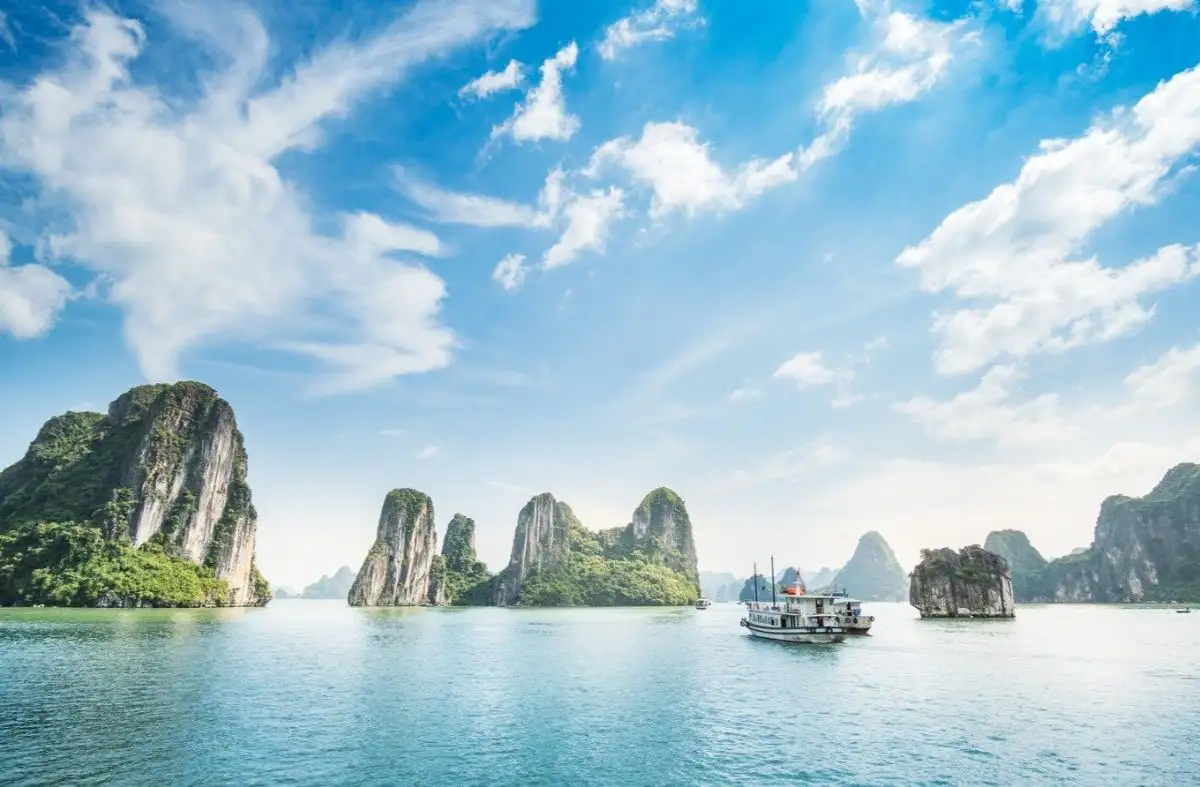
- Morning:
- Breakfast: Steam rice rolls with squid patties – This is a popular local breakfast in Ha Long. The soft, delicate rice rolls are served with golden-fried squid patties, creating a unique combination of coastal and northern flavors.
- Transfer from HaLong to Sapa: The journey takes about 6–7 hours. Along the way, travelers can admire majestic mountain landscapes, terraced fields, and winding roads cloaked in mist.
- Afternoon:
- Lunch: Grilled hill pig with bamboo-cooked sticky rice – This dish features pork from free-range pigs native to the highlands. The meat is tender and marinated with local spices before being grilled. It is served with sticky rice cooked in bamboo tubes, offering a fragrant and earthy taste.
- Explore Sapa town: Visitors can stroll along moss-covered stone streets, visit the old stone church, shop at the local market, and observe the daily life of the H’mong and Red Dao ethnic groups.
- Visit Silver Waterfall: This is one of the most beautiful waterfalls in Sapa, where white water cascades powerfully down the cliffs, surrounded by pristine nature.
- Evening:
- Dinner: Salmon hotpot: Sapa’s cold streams provide ideal conditions for farming salmon. The fish is firm and low in fat, perfect for hotpot, which is served with fresh mushrooms and wild vegetables.
- Explore Sapa night market: The market offers ethnic brocade, silver jewelry, and delicious street food such as grilled eggs, roasted chestnuts, and meat skewers.
Day 5: Sapa – Fansipan
- Morning:
- Breakfast: Smoked buffalo noodle soup: A unique breakfast in the highlands where thin slices of smoked buffalo meat are added to hot noodle soup, creating a rich, smoky flavor.
- Take the Fansipan cable car: Experience a modern cable car ride that lifts you through the clouds to the roof of Indochina, offering panoramic views of the rugged Northwest mountains.
- Afternoon:
- Lunch: Thang co (traditional horse meat stew): A long-standing dish of the Hmong people, Thang Co is made with horse meat and various highland herbs and spices, producing a strong, distinctive flavor.
- Visit Cat Cat village: This traditional village lies on a mountain slope with terraced rice fields and wooden houses. Visitors can watch linen weaving, try pounding rice, or rent ethnic costumes for photos.
- Visit Sapa stone church: Built from solid stone blocks, this Gothic-style church is a historical landmark of the town.
- Evening:
- Dinner: Sturgeon fish with sour bamboo shoot stew: Sturgeon raised in Sapa’s cold waters are fatty and flavorful. It is commonly stewed with sour bamboo shoots and forest herbs, ideal for cool mountain evenings.
- Enjoy a local cultural cafe: Built from solid stone blocks, this Gothic-style church is a historical landmark of the town.
Day 6: Sapa – Ninh Binh
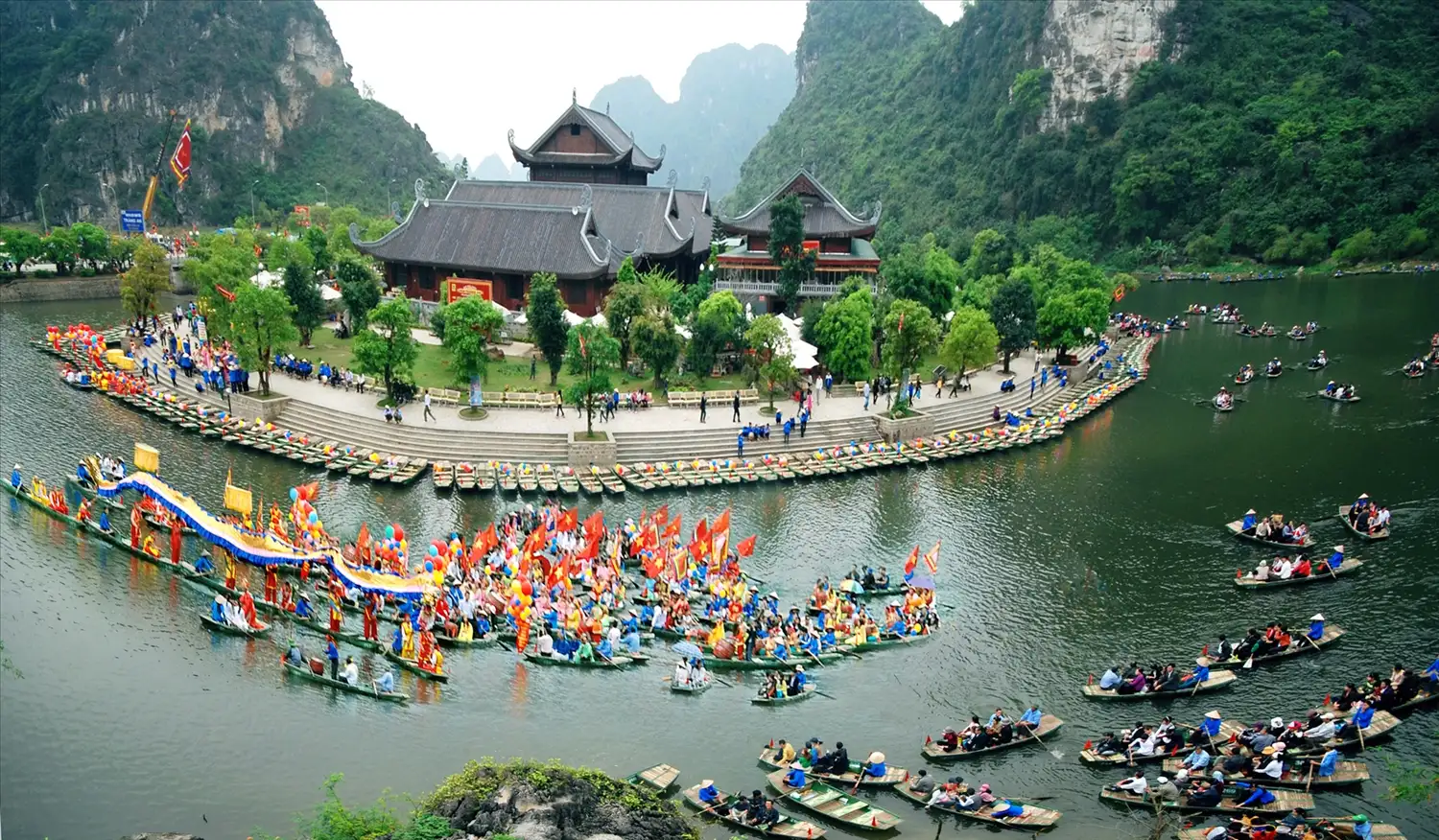
- Morning:
- Breakfast: Grill corn cake – a local H’mong specialty made from ground corn and spring water, shaped into flat cakes and grilled over charcoal for a warm, crispy texture.
- Transfer from Sapa to Ninh Binh: The journey takes approximately 8 hours, descending from the highlands to the Red River Delta. The route passes through lush valleys and towering limestone mountains.
- Afternoon:
- Lunch: Crispy rice with mountain goat meat: This iconic Ninh Binh dish combines crunchy golden rice with flavorful slices of tender mountain goat meat, often dipped in a special fermented sauce.
- Boat tour at Tam Coc – Bich Dong: Enjoy a scenic rowboat ride through serene rice paddies and limestone caves, with towering karst formations on both sides of the river.
- Visit Bai Dinh Pagoda: Explore one of the largest Buddhist complexes in Vietnam, known for its massive bronze statues and long corridors lined with hundreds of stone Arhat statues.
- Evening:
- Lunch: Goat meat with lime: This refreshing dish features thinly sliced goat meat marinated with lime juice, lemongrass, ginger, and herbs. It is light and flavorful—perfect for a warm evening.
- Walk around Hoa Lu Old Town: Discover the peaceful charm of Vietnam’s ancient capital, with its old temples, traditional architecture and local crafts.
Day 7: Ninh Binh – Phong Nha
- Morning:
- Eel porridge – A famous Ninh Binh specialty made from fresh field eels. The porridge is seasoned with turmeric and topped with crispy shallots, often served with crispy sesame rice crackers.
- Transfer to Phong Nha: The journey takes around 6–7 hours and passes through peaceful countryside scenery, rice fields, and winding rivers of central Vietnam.
- Afternoon:
- Lunch: Stewed goby fish with turmeric: Goby fish caught from the Son River are stewed with turmeric and local spices, resulting in a rich and flavorful dish that pairs perfectly with white rice.
- Explore Phong Nha – Ke Bang International Park: Discover incredible caves like Phong Nha Cave, Dark Cave, or En Cave by boat or on foot, and immerse yourself in unspoiled nature and karst landscapes.
- Evening:
- Dinner: Grilled hemibagrus fish in bamboo tube: Known locally as “ca mat”, this native fish is grilled inside bamboo tubes, retaining its natural sweetness and delicate texture, served with pepper-lime dipping salt.
- Stroll around Phong Nha village: Enjoy a peaceful village walk in the evening. You can join cultural music performances or participate in traditional cooking activities with local families.
Day 8: Phong Nha – Hue
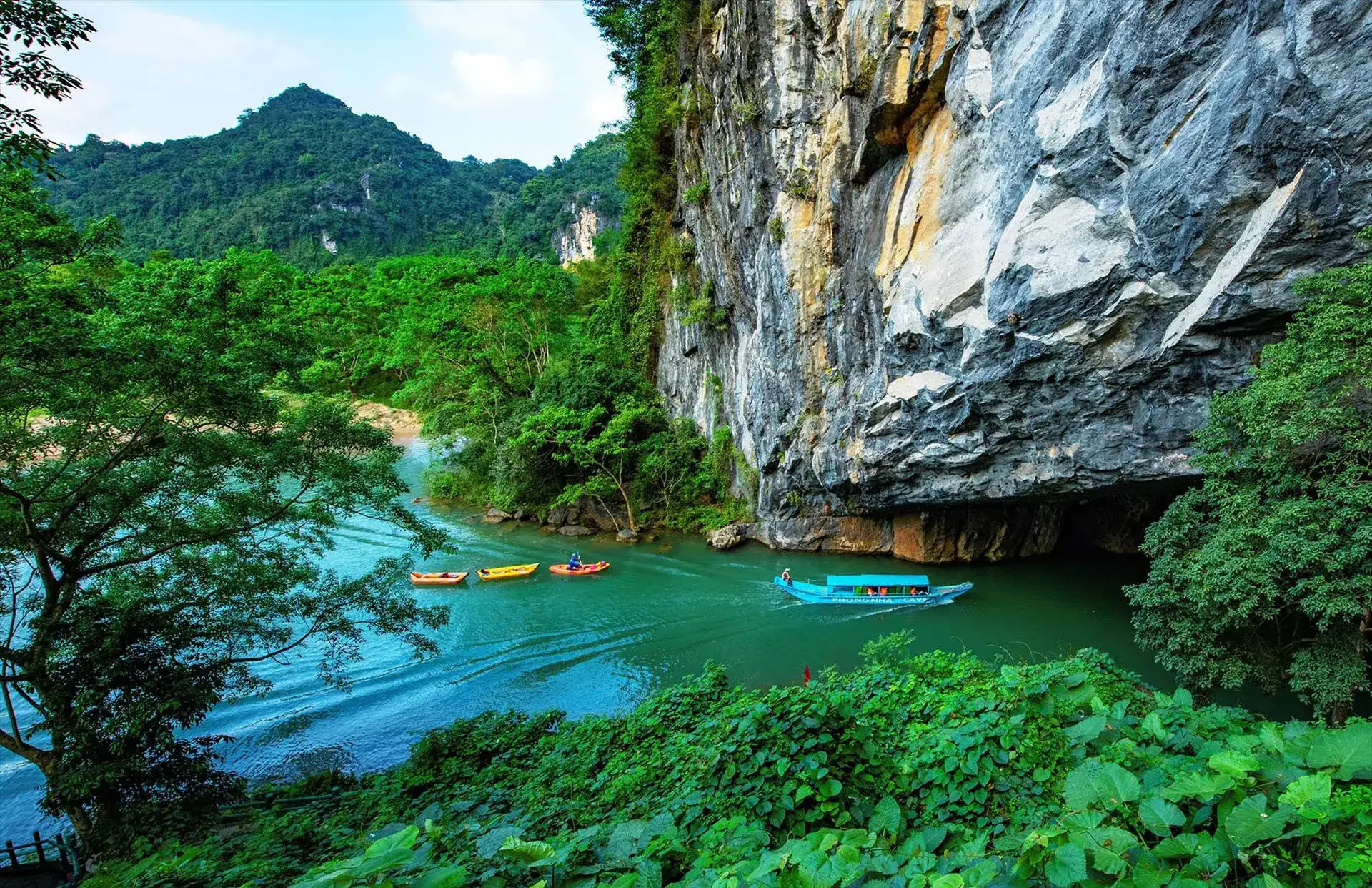
- Morning:
- Breakfast: Banh Loc (Tapioca dumplings): This local specialty features chewy dumplings filled with shrimp and pork belly, wrapped in banana leaves and steamed. It’s a popular morning snack in the central region.
- Transfer from Phong Nha to Hue: The trip takes around 4 hours, passing through historical landmarks along the former demilitarized zone (DMZ) and offering views of green fields and peaceful villages.
- Afternoon:
- Lunch: Com hen (baby clam rice): A Hue signature dish, com hen includes rice mixed with stir-fried baby clams, herbs, crispy pork rinds, and shrimp paste. It delivers a spicy, savory flavor that’s truly unique.
- Visit the Imperial city of Hue: Explore the UNESCO-listed Imperial Citadel, where you can walk through ancient gates, royal courtyards, and beautifully restored temples that reflect the glory of the Nguyen Dynasty.
- Take a boat ride on the Perfume River: Enjoy a relaxing dragon boat cruise past Thien Mu Pagoda and lush riverbanks, soaking in Hue’s poetic charm.
- Evening:
- Dinner: Bun bo Hue (Hue-style beef noodle soup) – A hearty bowl of spicy beef noodle soup with thick vermicelli, slices of brisket, pork knuckles, and lemongrass-flavored broth. It’s considered the soul of Hue cuisine.
- Experience Hue’s folk music on the Perfume River: In the evening, sit on a boat and listen to traditional ca Hue singing performed by local artists, offering a soothing cultural experience.
Day 9: Hue – Da Nang – Hoi An
- Morning:
- Breakfast: Banh khoai (Hue-style pancake): Crispy pancakes made with rice flour, filled with shrimp, pork, and bean sprouts, served with fermented soy dipping sauce. A lighter version of banh xeo but more refined in flavor.
- Transfer to Hoi An via Da Nang: The route takes about 3–4 hours, passing through the scenic Hai Van Pass with panoramic views of the sea and mountains. You can stop at Lang Co Beach and Marble Mountains along the way.
- Afternoon:
- Lunch: Mi Quang: A Da Nang specialty made from yellow rice noodles, topped with shrimp, pork, herbs, peanuts, and a rich broth served in small portions for deep flavor.
- Explore Hoi An Ancient Town: Wander through lantern-lit streets lined with wooden houses, tailors, tea shops, and traditional craft stores. Highlights include the Japanese Covered Bridge and Tan Ky Old House.
- Visit a lantern-making workshop: Try your hand at crafting a colorful silk lantern under the guidance of a local artisan. It’s a meaningful souvenir and a fun cultural activity.
- Evening:
- Dinner: Cao lau – Hoi An’s signature noodle dish, featuring chewy noodles, slices of pork, crispy croutons, and fresh herbs. Its unique texture comes from water drawn from ancient Cham wells.
- Enjoy the lantern-lit night market: As the sun sets, the town transforms into a magical space with glowing lanterns along the river. Browse handmade crafts, enjoy street snacks, and release paper lanterns on the water for good luck.
- Relax at Bliss Hoi An Beach Resort & Wellness: Bliss Hoi An is the perfect stop to unwind during your Central Vietnam journey. Located on the pristine Binh Minh beach, the resort features an oceanfront infinity pool, rejuvenating spa treatments, and a peaceful, authentic Vietnamese atmosphere. It is an ideal place to recharge before continuing your two-week Vietnam adventure.
Day 10: Hoi An – My Son Sanctuary – Hoi An

- Morning:
- Breakfast: Chicken rice (Com ga Hoi An): This dish features fragrant yellow rice cooked in chicken broth, served with shredded chicken, pickled papaya, and herbs. It’s a must-try breakfast in Hoi An.
- Half-day tour to My Son Sanctuary: Travel to the UNESCO World Heritage Site of My Son, home to ancient Cham temples nestled in a lush valley. Explore the red brick ruins and learn about Cham history and Hindu influence in Vietnam.
Read more: My Son Sanctuary Vietnam – Champa cultural heritage
- Afternoon:
- Lunch: Grilled pork skewers with rice paper: Enjoy flavorful grilled pork served with rice paper, fresh vegetables, and dipping sauce. Wrap your own rolls and savor the mix of smoky, sweet, and sour tastes.
- Relax at An Bang Beach: Spend a peaceful afternoon at An Bang Beach. You can swim, sunbathe, or enjoy a coconut by the shore. The beach is clean, calm, and less crowded than Da Nang’s.
- Evening:
- Dinner: White rose dumplings (Banh bao banh vac): A delicate Hoi An delicacy made from translucent rice flour dumplings filled with minced shrimp and topped with crispy shallots. Often served with a tangy dipping sauce.
- Stroll through Hoi An’s riverside promenade: End the night with a walk along the Thu Bon River, watching lantern boats glide across the water, and absorbing the serene atmosphere of this historic town.
Day 11: Hoi An – Da Nang – Nha Trang
- Morning:
- Breakfast: A bowl of beef stew with bread: This hearty Vietnamese dish features tender beef chunks slowly simmered with carrots and aromatic spices, served with crusty baguette for dipping.
- Travel to Da Nang then take a domestic flight to Nha Trang: The flight usually takes around 1 hour and 15 minutes. Upon arrival, you will transfer to the city center and check in to your hotel.
- Afternoon:
- Lunch: Nem nuong Ninh Hoa: This is a signature grilled pork sausage dish from the Nha Trang region, served with rice paper, fresh herbs, pickled vegetables, and a flavorful dipping sauce.
- Visit the Po Nagar Cham Towers: This complex of ancient Hindu temples was built by the Cham civilization between the 7th and 12th centuries. The towers sit on a hill overlooking the Cai River and offer stunning views and cultural insights.
- Take a stroll along Nha Trang Beach.
- Evening:
- Dinner: Bun Cha Ca: This fish cake noodle soup is light yet flavorful, made with tender fish cakes, tomatoes, pineapple, and fresh herbs in a clear broth.
- Explore the Nha Trang Night Market, where you can find local handicrafts, street food, and souvenirs.
Day 12: Nha Trang Island Hopping
- Morning:
- Breakfast: Banh can Nha Trang: These are mini rice flour pancakes filled with eggs, shrimp, or squid, served with a savory dipping sauce and fresh greens.
- Join an island-hopping boat tour around Nha Trang Bay: The tour often includes visits to Mun Island, Mot Island, and Tam Island. You can snorkel to see coral reefs, swim in crystal-clear waters, or simply relax on the beach.
- Afternoon:
- Lunch: Seafood meal: Often featuring fresh grilled shrimp, steamed clams, and fish cooked with local herbs.
- Continue boat tour, sunbathe or participate in water spots like kayaking or parasailing.
- Evening:
- Dinner: Lobster grilled with garlic butter.
- Visit a rooftop bar or beachfront café to enjoy the ocean breeze and a panoramic view of the city at night.
Day 13: Nha Trang to Ho Chi Minh City
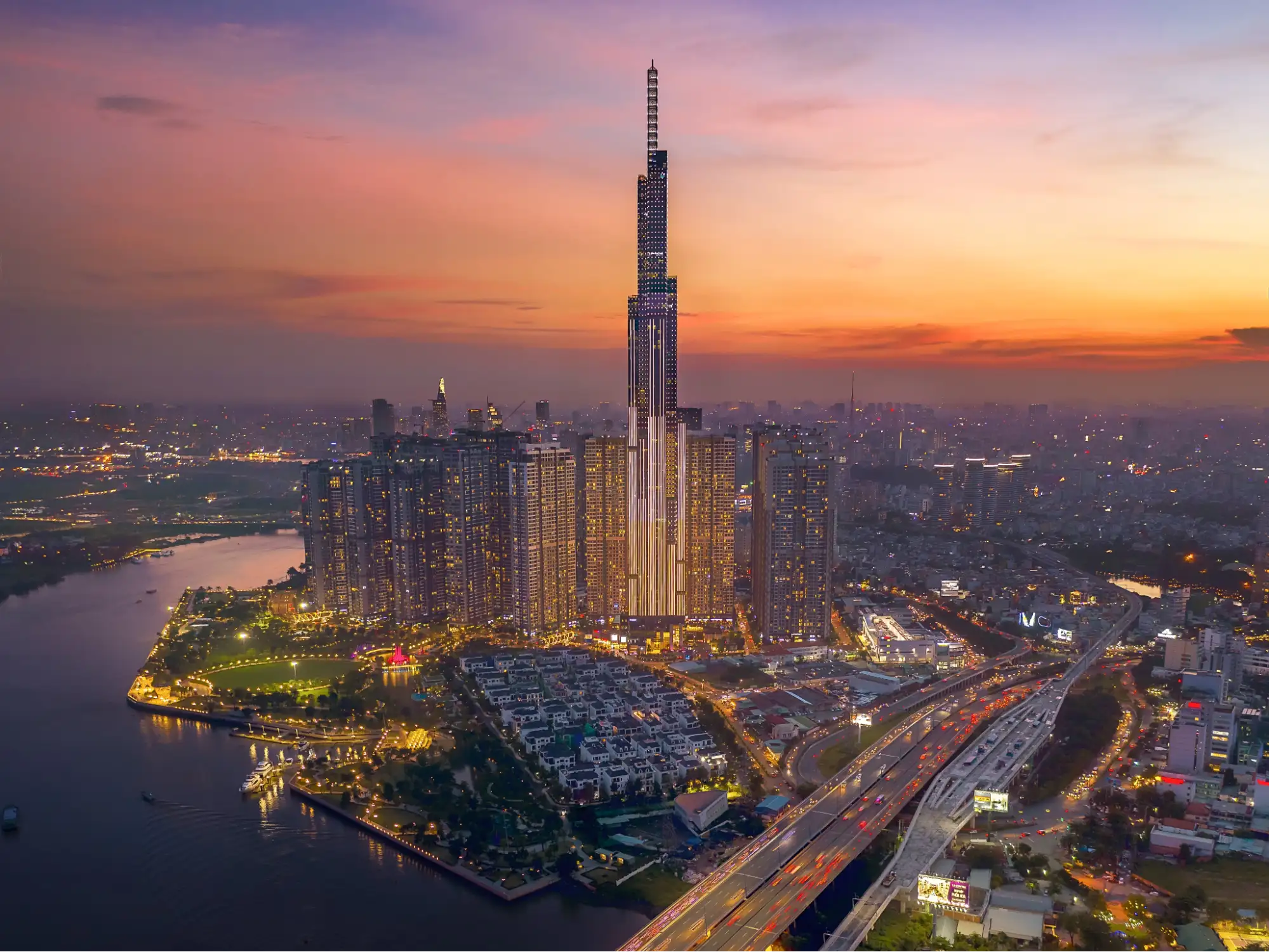
- Morning:
- Breakfast: Xoi man. This savory sticky rice dish is topped with sausage, shredded chicken, and scallion oil, making it a popular morning option.
- Transfer to Cam Ranh Airport and take a flight to Ho Chi Minh City. The flight usually takes around 1 hour and 10 minutes. Upon arrival, you will transfer to your hotel and rest briefly.
- Afternoon:
- Lunch: Hu tieu Nam Vang. This southern-style noodle soup is made with pork, shrimp, quail eggs, and a clear, slightly sweet broth.
- Visit the War Remnants Museum to learn about Vietnam’s modern history. Then, you can stop by the Independence Palace, where important events of the Vietnam War took place.
- Walk along Dong Khoi Street and admire colonial buildings such as the Saigon Notre-Dame Cathedral and the Central Post Office.
- Evening:
- Dinner: Com tam. This broken rice dish is served with grilled pork chops, shredded pork skin, and pickled vegetables.
- Explore the Ben Thanh Night Market to shop for souvenirs and sample street snacks.
Day 14: Ho Chi Minh City and Departure
- Morning:
- Breakfast: Banh mi op la. This Vietnamese baguette is served with sunny-side-up eggs, pate, and soy sauce.
- Visit a local market such as Binh Tay Market in District 5 to experience the bustling energy of Chinatown.
- Check out of your hotel and transfer to Tan Son Nhat International Airport for your departure flight.
Important tips when traveling Vietnam in 2 weeks
Here are some important tips to ensure a smooth and enjoyable trip on how to travel Vietnam in 2 weeks:

- Weather variations: Vietnam’s climate varies greatly from region to region. Be prepared for cooler temperatures in the north and warmer, more humid conditions in the south. Pack layers, especially if you’re traveling from the mountains to the coast.
- Local transportation: Public transportation is available but may not always be reliable or convenient. Consider booking private cars, trains, or buses for long-distance travel. Grab taxis or ride-hailing services are common in cities.
- Cultural sensitivity: Vietnam is a country with deep cultural traditions. When visiting temples, pagodas, or local villages, dress modestly and be respectful. Always ask before taking photos of people, especially in rural areas.
- Currency: The local currency is the Vietnamese Dong (VND). While larger cities may accept credit cards, it’s always wise to carry cash, especially when traveling to more remote areas.
- Language barrier: Learning a few basic Vietnamese phrases can enhance your experience and help with communication.
Knowing how to travel Vietnam in 2 weeks opens up the perfect opportunity to experience the country’s stunning landscapes, rich history, and vibrant cultures. With careful planning, your two-week journey will allow you to embrace Vietnam’s diversity and leave you with unforgettable memories and a deeper connection to this beautiful country.

